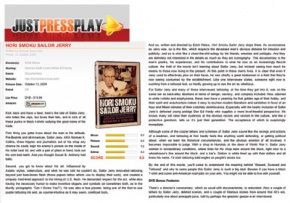News
Review on Just Press Play.com
10/16/09
Just Press Play.com

Hori Smoku Sailor Jerry
Written by Michael Narkunski
Friday, 16 October 2009
Kick back and have a beer; here’s the tale of Sailor Jerry, who hates the Japs, but loves their tats, and is sick of all these punks in black t-shirts sullying the good name of his trade.
First thing you gotta know about the man is his attitude. Pre-Beatnik and all-American, Sailor Jerry, AKA Norman K. Collins, threw hippies and journalists out of his shop any chance he could, kept his enemy’s picture on the inside of his toilet seat lid, and with a pair of pliers in hand, took out his own bad teeth. And you thought Susan B. Anthony had balls.
Second, you got to know about his art. Influenced by Asiatic styles, watercolors, and what he was told he couldn’t do, Sailor Jerry innovated tattooing beyond just bare-bones flash (those papers tattoo artists use to display their work), and created a uniquely hard-lined approach to the inking of U.S. flesh. He demanded respect for the act, while also having the necessary humor to make inventive slogans and symbols (or sometimes both, as in the bluntly pictographic “Can I Screw You?”). He was also a true pioneer, being one of the first to use purple tattooing ink and, as counter-intuitive as it may seem, sterilized tools.
And so, written and directed by Erich Weiss, Hori Smoku Sailor Jerry stops there. As no-nonsense as Jerry was, so is the film, which respects the deceased man’s obvious distaste for intrusion and publicity, and so is shot like a shoot-the-shit eulogy by his friends, enemies and protégés. And they are definitely not interested in life details as much as they are iconography. This documentary is the man’s pranks, his experiences, and his contributions to what he saw as an increasingly flaccid culture; the thrill of the movie isn’t learning about Sailor Jerry, but instead seeing how much he means to those now living in the present. At this point in these men's lives, it is clear that even if Jerry used to effectively piss on their faces, he was chiefly a great tradesman in a field that they're now seeing consumed by the establishment. Like one interviewee states, someone right now is suckling from a tattooed teat, so hardly growing up to see the art as rebellious.
For Sailor Jerry and many of those interviewed, tattooing, at the time they got into it, was on the same bar as back-alley abortions in terms of danger, secrecy, and company included. Now, adorned in white t-shirts and emphysema, these men have a yearning for that golden age of their hobby, and their spirit and anachronism makes it easy to eschew modern liberalism and sanitation in favor of an hour and fifteen minutes of their crotchety reminiscence. Especially with the hearty inclusion of Sailor Jerry’s defected young protégé Don Ed Hardy who supplies a more level-headed perspective. He knows many will raise their eyebrows at the obvious racism and sexism in the culture, and like a protective grandson, tells us it’s just their generation. The acceptance of which is surprisingly immediate.
Although some of the crazier letters and schemes of Sailor Jerry sound like the ravings and actions of a madman, and tattooing at first hardly feels like anything worth defending, or getting political about, when we learn his historical circumstances, and the obvious emotion of all involved, it becomes impossible to judge. With a shop in Honolulu at the dawn of World War II, Sailor Jerry worked in extraordinary conditions, where lines for his shop were around the block, right next to a whorehouse’s line around the block, and a bar’s. Sailors in white lined up with their dollars and all knew his name. I’d start tattooing bald eagles on people's asses too.
By the end of this movie, you’ll come to understand the meaning behind “Stewed, Screwed and Tattooed” and why to some people this Sailor Jerry is such a big deal. Beware if you have a black T-shirt and some anti-American rush-jobs on your arm. You might not be able to live with yourself.
DVD Bonus Features:
There’s a director’s commentary, which as usual with documentaries, is redundant. Also a couple of letters by Sailor Jerry, deleted scenes, and a couple of hilarious stories from around that 40’s era, particularly one about pineapple juice, told by perhaps the geeziest geezer ever interviewed.
